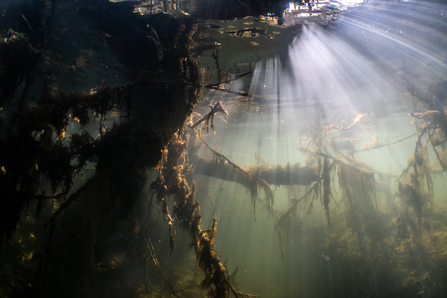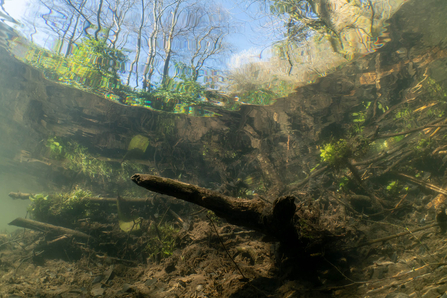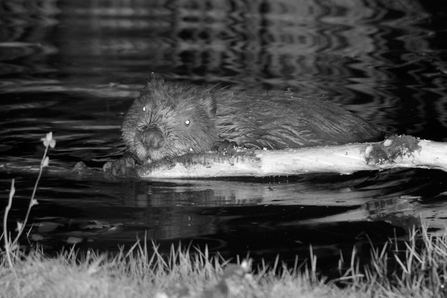Beavers in enclosures
Devon Wildlife Trust's Enclosed Beaver Project
Since 2010 Devon Wildlife Trust has been running a beaver project on a securely-fenced, private site in western Devon.
Beaver. Photo, Andrew Taylor
A pair of beavers was first introduced to a 2.8 hectare plot of wet woodland and rough grassland in 2011. The initial aim was to see if beavers could help manage the Culm grassland habitats on the site in a sustainable way.
The wet, rushy pasture known as Culm grassland, historically found across much of northern Devon, is an important habitat for many species of wildflowers, insects and other wildlife. But it can be lost to scrub – could beaver activity help maintain the Culm grassland in the best possible condition for other wildlife to thrive?

Below the surface, behind a beaver dam, photo copyright Henley Spiers
In fact, the beavers transformed the site into a flourishing wetland, with many ponds connected by canals engineered by the animals themselves.
The aerial footage you can see further down this page shows the complex wetland that the beavers have created at this site.

Beaver dam from below the surface, photo copyright Henley Spiers
The project began with the construction of a secure fence, that beavers could neither climb over nor dig beneath to leave the enclosure. With funding from Viridor Credits Environmental Company and the Truell Charitable Foundation secured and the site prepared, local beaver expert Derek Gow supplied the first pair of beavers on the site.
Working closely with scientists from Professor Richard Brazier’s research group at the University of Exeter, the Enclosed Beaver Project site supplied ground-breaking research on the effects of beaver dams on water flows. (Funding from Westland Countryside Stewards enabled the University to install state of the art equipment in this site.)
Since 2011, we have monitored the impact of beavers in the enclosure on:
- Trees and other plants
- Wildlife populations, including amphibians, bats & breeding birds
- Water levels and flow rates through the site
- Water quality either side of beaver dams
A summary of the research work was published in a 2017 report: Beavers – Nature’s Water Engineers
Plymouth Beavers
In 2020, the first urban beavers in Britain were introduced into Poole Farm within the Derriford Community Park in Plymouth. Led by Plymouth City Council, DWT has provided support and expertise to this project.
A male beaver was introduced into the 3.5 hectare enclosure in November 2020, followed by a female in January 2021. Both mammals were sourced from Scotland. The site features 600 metres of waterway in a wooded valley.
Sadly, the beavers were able to escape this enclosure and the female was killed in a road traffic collision. The habitats remain very suitable for beavers but the fencing needs to be reinforced so Plymouth City Council decided in July 2021 to re-home the male beaver while improvements are made to the enclosure. Find out more about this decision.

Beaver at Enclosed Beaver Project site, photo Nick Upton
With beavers in an urban area, research on the social and public perception of the animals and their activities will be particularly important. This work is being led by Roger Auster from the University of Exeter, who will be monitoring how perceptions change over time.
Find out more about the Plymouth beavers at https://greenmindsplymouth.com
Help us continue research at the Enclosed Beaver Project site
Find out more about the first years of the Enclosed Beaver Project.
